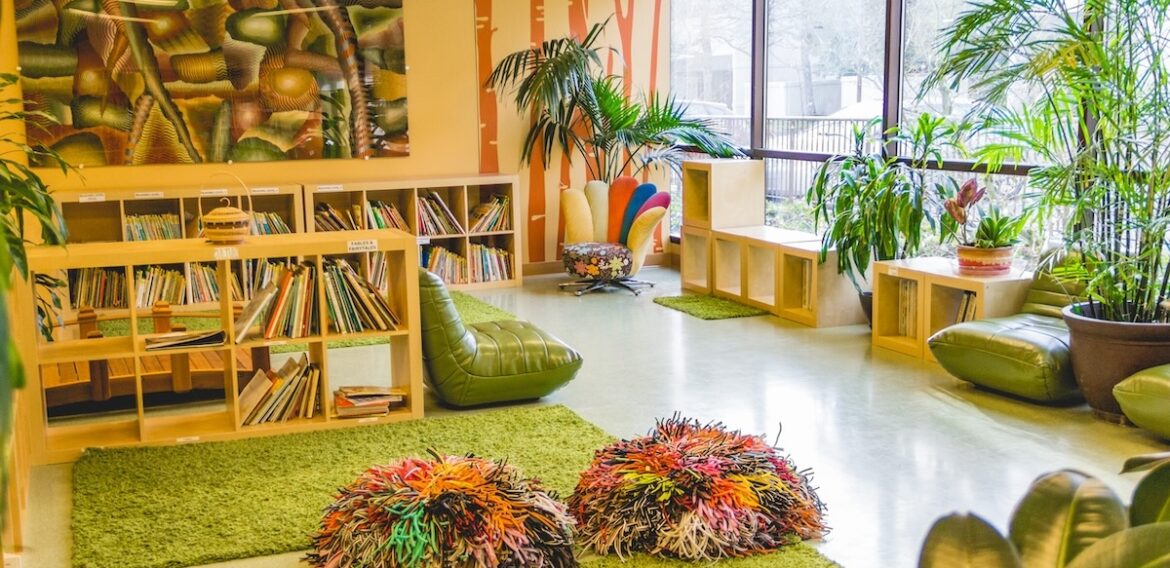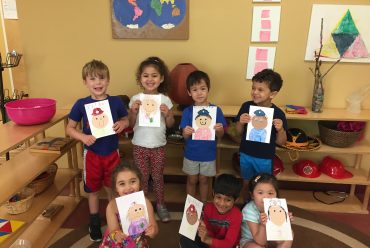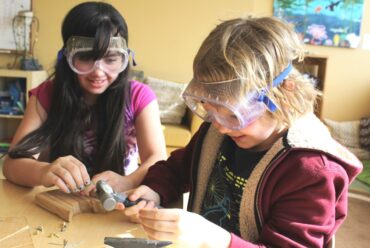Pillar One: Environment – Fostering Independence and Responsibility
At Living Montessori, fostering independence and responsibility in children is a crucial aspect of their development. Here are some insights into how independence and responsibility are fostered through your child’s environment and how it is integrated in our Infant-toddler, Preschool, and Elementary programs.
-
Encouraging Self-Sufficiency:
Montessori environments are thoughtfully structured to enable children to undertake tasks independently. This includes practical life activities such as dressing themselves, preparing snacks, cleaning up, and taking care of personal needs. Activities such as these are central to the Montessori philosophy as they foster a sense of accomplishment, confidence, and self-reliance. Here are some examples of ways to encourage self-sufficiency in the way a child’s environment is set up.
- Prepare accessible spaces: Ensure easy access to commonly used items (ex. Set. For example, set up a cleaning station with a child size dustpan and small towels that your child can access, for example, a dustpan and towels for any spills they might cause).. Show him or her how to use the tools and encourage them to practice cleaning tasks at their own pace. Allow mistakes and time to achieve mastery.
- Child friendly kitchen: Designate a low shelf or drawer in the kitchen for your child’s plates, cups, and utensils. Encourage them to participate in mealtime preparation and clean-up; this can promote a sense of responsibility and accomplishment.
- Personalized Wardrobe: Organize your child’s wardrobe in a way that makes it easy for them to choose their clothes. This can help your child gain independence in dressing and allows them to take pride in making small decisions about their appearance.
-
Providing Opportunities for Decision-Making:
Children in Montessori settings are given choices within structured parameters. This could involve selecting activities or materials they want to work with, deciding on the sequence of tasks, or choosing from a set of options. These choices empower children, encourage critical thinking, and help develop decision-making skills. Here are some examples of ways to provide opportunities for decision-making within your child’s environment:
- Clothing Selection: Allow your child to choose his or her outfits for the day by making it easy for them access to their personal wardrobe (as mentioned above) or lay out a couple of appropriate options and let them decide what to wear. This promotes independence in dressing and allows for self-expression.
- Activity Choices/Work Cycle: Give your child an uninterrupted block of time to engage in self-chosen activities. Set up a space where your child can see a few activity choices. AllowGive them the freedom to choose the order in which activity they would like to work on first, giving them freedom thatthese activities are done. This freedom promotes independent learning, and fostersa growth mind set while fostering a sense of responsibility and time management especially in Kindergarten and Elementary age children.
- Choice of Reading Material: Create a designated reading area with a variety of age-appropriate books. Let your child independently choose a book they would like to read or use as part of a shared reading experience. This cultivates a love for literature and autonomy in decision-making.
- Family Outings: Offer age-appropriate options for family outings or activities. Whether it is a trip to the park, the zoo, or a museum. Present a few options and let your child have a say in the family’s plans.
-
Developing a Sense of Ownership:
Children are encouraged to take responsibility for their actions and their environment. They are taught to care for their belongings, tidy up after themselves, and respect the classroom or home environment. This cultivates a sense of ownership and accountability. Here are some ways to enhance your child’s environment to develop their sense of ownership:
- In the Bedroom: Let your child choose their bedding or decorative items for their bed, fostering a sense of personal space and ownership. (WhenFor younger children you may preselect items they really appreciate their can choose from. Children are likely to take care of personal belongings, that they typically take extra good care of them).appreciate or have a say in.
- In the Kitchen: Encourage your child to help with food prep by providing them with their own child-sized utensils, and designated workspace. Allow them to wash and cut fruits and vegetables. Preschool age children can easily prepare simple meals while Kindergarten and Elementary children may delve into experimenting with and/or learning basic cooking techniques. Children’s involvement in the kitchen can promote healthy eating habits, while cultivating a sense of responsibility and respect for their kitchen environment.
- In the Bathroom: Use a sturdy step stool in areas such as the bathroom or kitchen, empowering your child to reach sinks and countertops independently. Place child-friendly toiletries on a low shelf in the bathroom, enabling your child to take responsibility for their personal care routines.
-
Gradual Increase in Responsibilities:
The Montessori approach advocates for gradually increasing responsibilities as children grow older and develop more skills. This progression allows children to build upon previously acquired skills and take on more complex tasks or challenges, instilling a sense of confidence in their abilities. Here are some examples of ways to gradually increase your child’s responsibilities in their environment:
- Self-care: In the early years, teach your child to wash hands independently and introduce basic dressing skills, such as taking off socks and shoes. As they grow, introduce more complex tasks like buttoning, zipping, and tying shoelaces.
- Mealtime Responsibilities: In the early years, allow your child to help set the table with simple tasks like placing napkins or utensils. As they grow, introduce more responsibilities, such as pouring water into their cup and serving themselves. Teach basic food prep like chopping and move to making soups, sandwiches, and baking. Allow them to take care of the cleanup responsibilities bysuch as washing dishes and cleaning the table.
- Organization and Order: Create a designated space for your child’s toys and teach them to put them away. As early as Toddler and Preschool age children can be introduced to categorizing and sorting their belongings. Encourage your child to independently tidy their room and maintain order in shared spaces. It is easier for children to successfully clean up areas with fewer items that are organized in categories.
- Academic Independence: Allow your child to choose their learning activities from a selection of Montessori and other open-ended and purposeful learning materials. As they grow, gradually increase the complexity of learning materials, and offer choices to dive deeper within specific academic areas.
- Community Involvement: Participate in simple community service activities together, likesuch as picking up trash in a local park. As they grow, engage in more complex community projects, involving your child in decisions about appropriate projects of their interest. Encourage discussions about community needs and how your child can contribute. as well as the impact it can have. Children that learn to take responsibility for themselves first are more likely to have the confidence to contribute in a community.
-
Promoting Problem-Solving Skills:
When children are given the autonomy to make choices and solve problems independently, they learn valuable problem-solving skills. Teachers and parents act as guides, offering support and encouragement as children navigate challenges. Here are some examples of ways to promote problem solving skills in your child’s environment:
- Grace and Courtesy Lessons: Encourage your child to find solutions to social challenges within their peer group independently, fostering emotional intelligence and conflict resolution skills. (Do not quickly break up an argument or immediately interfere with a difficult emotion or conversation). Ask questions rather than giving answers.. Observe first to see what your child can work out. Inquire rather than providing solutions. If they need help prompt questions that invite thinking.
- Mixed Ages: Find opportunities for your child to be around children of different ages, older and younger. Younger children can observe and learn from older peers and older children recognize how they can act as mentors, modeling problem solving skills and collaborative learning.
- Small Repairs: Introduce small repair tasks, such as fixing a loose button or assembling a simple piece of furniture. Guide (and coach) your child through the process, fostering problem-solving skills and independence.
- Discussion and Reflection: Help your child reflect on how a situation turned out and think about lessons learned. Engage in discussions about real-life situations and hypothetical scenarios. Encourage your child to consider different perspectives and propose solutions to problems.
- Activities that require problem solving: Provide toys or activities that require problem solving and critical thinking. Allow your child plenty of uninterrupted time to explore and discover solutions before helping.
- Avoid learning through screen time: Research has shown that real life situations, experienced through active engagement, stimulate the brain into active rather than passive learning, firing up the neurons.
To incorporate these principles into your parenting or teaching style, remember the following:
- Provide opportunities for your child to take on age-appropriate tasks and gradually increase responsibilities as they demonstrate readiness.
- Allow your child to make choices within boundaries that you establish, promoting a sense of autonomy and decision-making.
- Encourage your child to tidy up after themselves and take care of their belongings and take on age-appropriate household tasks to instill a sense of responsibility.
- Be a supportive guide rather than always directing or controlling their actions, allowing them space to learn and grow through real life experiences.
- Allow your child the inner joy that comes from knowing I can do it, I can figured it out, rather than looking for external praise.
In summary, the Montessori approach to raising well-adjusted children advocates a departure from traditional methods rooted in external validation, fostering a transformative journey centered on the five pillars of inner guidance, self-regulation, self-direction, self-evaluation, and confidence in one’s inner voice. By recognizing and meeting children’s natural needs for freedom, order, and boundaries, the Montessori method creates an environment that nurtures independence while providing appropriate guidance. This approach serves as a roadmap for empowering children to navigate their world confidently, breaking the cycle of external validation, and fostering the development of self-assured individuals.
Responsible children take pride in themselves and make positive contributions to their families and communities.
We sincerely hope this provides practical ideas to easily implement. We would love to hear your feedback and questions.
Citations
- American Montessori Society (AMS) – The Importance of a Simple Environment
- Montelores Early Childhood Council – The Whole-Brain Child 12 Revolutionary Strategies to Nurture Your Child’s Developing Mind [PDF]
- Living Montessori – Montessori Method
- Living Montessori – 5 Pillars Of Raising Well-Adjusted Children The Montessori Way.







